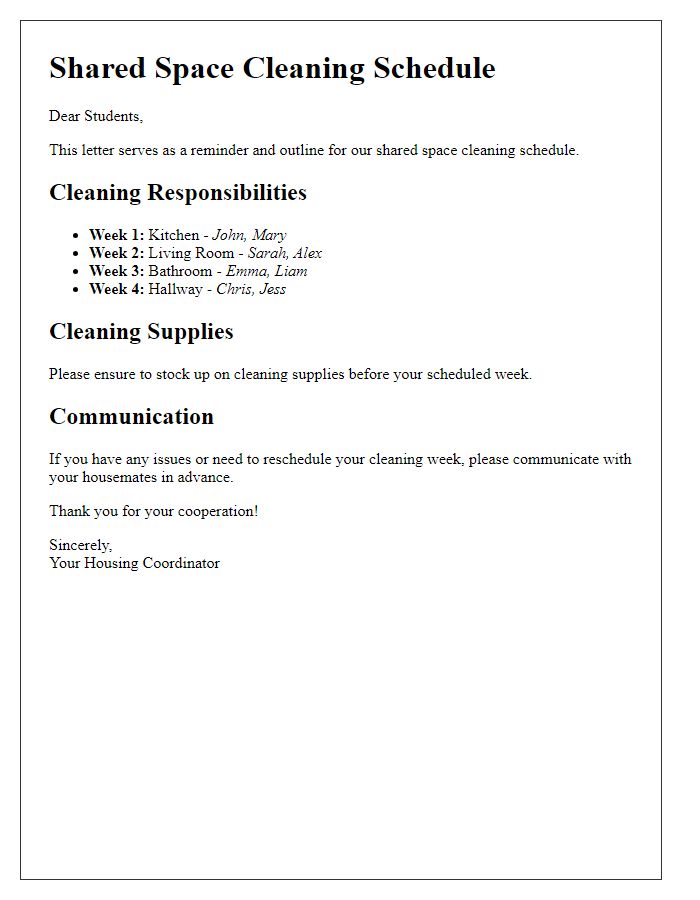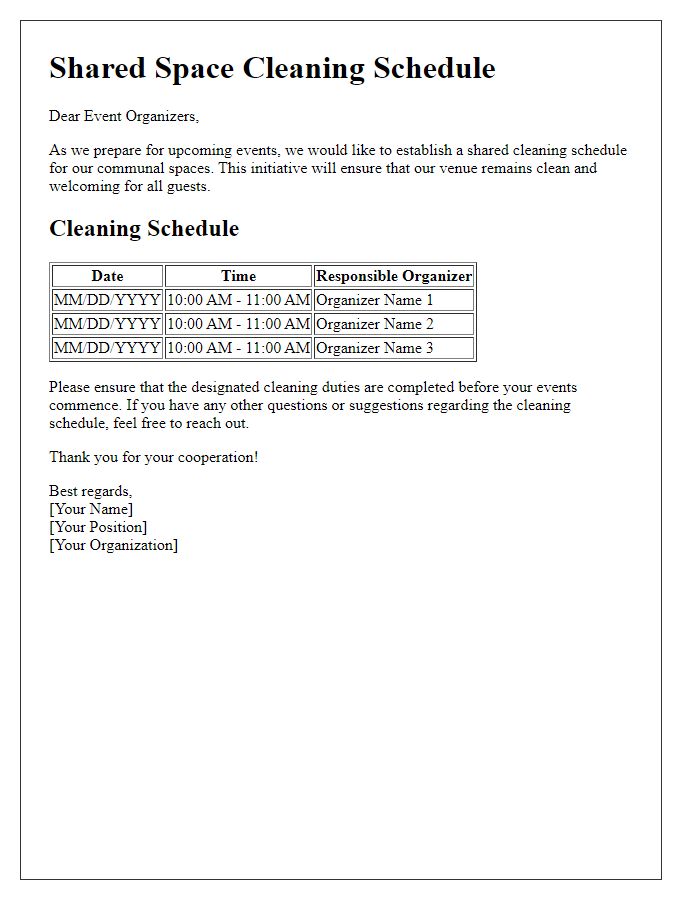Keeping our shared space clean and tidy is essential for creating a pleasant environment for everyone. Establishing a cleaning schedule not only ensures that responsibilities are clear, but also fosters a sense of community among us. Imagine how satisfying it will be to see our common areas sparkling clean and welcoming! If you're curious about how to set up the perfect cleaning schedule, read on for some helpful tips!

Introduction and Purpose
The introduction of a shared space cleaning schedule aims to establish a structured routine for maintaining cleanliness and hygiene in communal areas, such as kitchens, bathrooms, and common rooms within residential buildings or office environments. The purpose of this initiative is to foster a collaborative effort among residents or team members, ensuring that every individual contributes to the upkeep of these spaces. By setting specific days and tasks, this schedule helps to minimize clutter, promote organization, and create a welcoming atmosphere for all users. Regular cleaning not only enhances the aesthetic appeal of shared spaces but also supports health and safety standards, reducing the risk of illness caused by unclean surfaces.
Cleaning Schedule Details
A shared space cleaning schedule can significantly enhance the cleanliness and organization of communal areas, such as apartments, offices, or co-working spaces. Regular cleaning intervals (weekly or bi-weekly) should be established, detailing specific responsibilities assigned to each resident or employee. Key areas include kitchens, bathrooms, and lounges, which may require more frequent attention due to high traffic. Incorporating a rotating system ensures equitable distribution of tasks, avoiding any perception of unfair workload. Clear communication with a shared digital calendar or physical notice board, including specific dates (such as the 1st and 15th of each month), fosters accountability and encourages cooperation among participants.
Assigned Responsibilities
A cleaning schedule for the communal area in an apartment building is essential for maintaining order and hygiene. Each resident is assigned a specific task every week to ensure that shared spaces, such as the kitchen, laundry room, and lounge, remain clean and welcoming. Responsibilities include vacuuming high-traffic areas (typically done weekly on Fridays), wiping down surfaces such as countertops and tables, and emptying trash bins (to be completed on Tuesdays). Special notes highlight the importance of using eco-friendly cleaning products to minimize environmental impact. The cooperation and accountability of all residents contribute significantly to a pleasant living environment, promoting a sense of community and shared responsibility.
Reporting and Feedback Procedures
Shared workspace cleaning schedules are essential for maintaining cleanliness and organization in communal areas like kitchens, break rooms, and meeting spaces. Implementing a structured reporting and feedback procedure ensures that all team members, such as marketing or IT staff, engage in regular cleaning tasks on a weekly basis. Specific responsibilities can be assigned on a rotating basis, ensuring accountability for areas like trash disposal and surface sanitization. Feedback can be collected through digital platforms like Google Forms, allowing users to report issues such as spills or maintenance needs, which can be addressed promptly by facilities management. This systematic approach fosters a positive environment in office buildings, enhancing productivity and teamwork among employees.
Contact Information
A shared space cleaning schedule facilitates the maintenance of communal environments, such as office break rooms or residential shared kitchens. This plan outlines specific days and times designated for cleaning tasks, ensuring that all users contribute to the upkeep. For example, on Mondays, one individual may be responsible for wiping down surfaces and emptying the trash cans, while Fridays can be reserved for deep cleaning tasks like mopping floors or sanitizing appliances. Clear communication is essential, so including contact information such as email addresses or phone numbers for each participant enables quick coordination and adjustments to the schedule as needed. This structured approach promotes accountability and ensures a pleasant environment for everyone involved.
Letter Template For Shared Space Cleaning Schedule Samples
Letter template of shared space cleaning schedule for apartment residents

Letter template of shared space cleaning schedule for neighborhood association












Comments